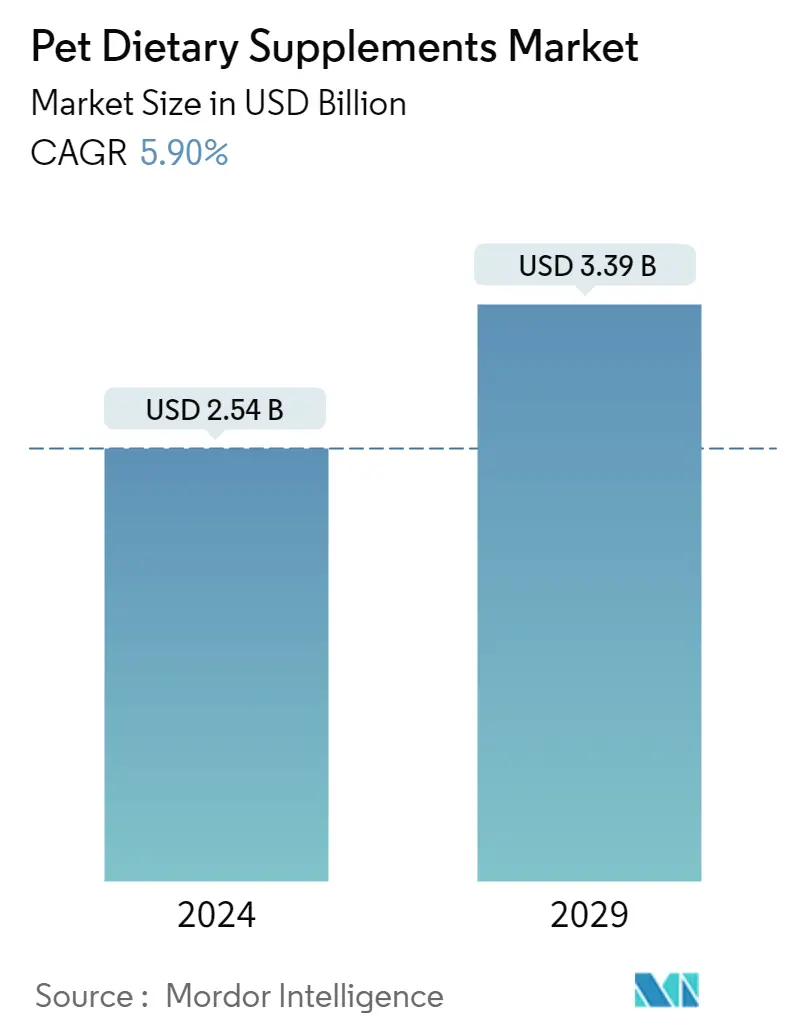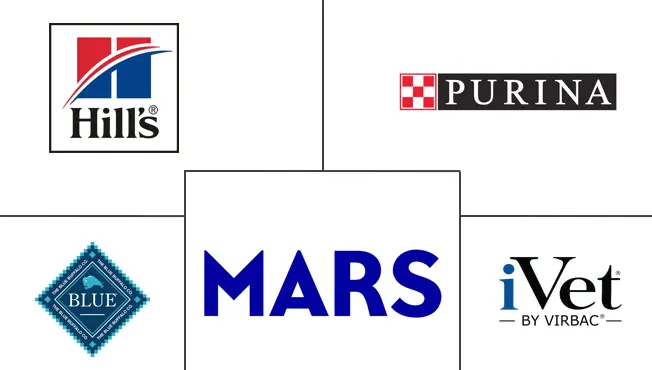Market Size of Pet Dietary Supplements Industry

| Study Period | 2019 - 2029 |
| Market Size (2024) | USD 2.54 Billion |
| Market Size (2029) | USD 3.39 Billion |
| CAGR (2024 - 2029) | 5.90 % |
| Fastest Growing Market | Asia-Pacific |
| Largest Market | North America |
Major Players
*Disclaimer: Major Players sorted in no particular order |
Pet Dietary Supplements Market Analysis
The Pet Dietary Supplements Market size is estimated at USD 2.54 billion in 2024, and is expected to reach USD 3.39 billion by 2029, growing at a CAGR of 5.90% during the forecast period (2024-2029).
- Dietary supplements comprise animal foods specifically formulated to aid in managing illnesses and diagnosed health disorders, such as itchy skin, digestive issues, obesity, allergies, etc., in pets. Brand value enhancement in North America, Latin America, and the emerging countries of Asia-Pacific and consumer awareness about premium products fuel the growth of the market. Multinational players are making significant investments in increasing product awareness to strengthen consumer preference through several channels.
- Moreover, the market has witnessed the growth of start-up companies and acquisitions by the major players in the pet industry to enter the market. For instance, People for Pets, launched in 2021, achieved impressive growth by setting a new standard for dog supplements. The company launched Nectar of the Dogs, the first range of Australian-made, plant-based, medicinal water treats, and was acquired by the Australian Real Pet Food Company in 2022.
- Further, the dog segment of the dietary supplement market is likely to witness the fastest growth over the forecast period. Dog owners' interest in purchasing healthy and nutritious foods for their pets drives the sales of different types of dog foods globally, leading to the launch of various dietary supplement products. Further, the rising pet dog population worldwide, coupled with the increasing health concerns of pet owners, leads to an increase in global sales of dog dietary supplements during the forecast period.
Pet Dietary Supplements Industry Segmentation
Pet dietary supplements are feed supplements used in conjunction with pet food to improve the nutritive balance or performance of the pet food consumed. The Pet Dietary Supplements Market is segmented by Specialty Type (Urinary Tract Diseases, Diabetes, Renal, Digestive Sensitivity, Oral Care, and Other Specialty Types), Pet Type (Dog, Cat, Bird, and Other Pet Types), and Geography (North America, Europe, Asia-Pacific, South America, and Middle East and Africa). The report offers market size and forecasts in terms of value (in USD million) for the above-mentioned segments.
| Specialty Type | |
| Urinary Tract Disease | |
| Diabetes | |
| Renal | |
| Digestive Sensitivity | |
| Oral Care | |
| Other Specialty Types |
| Pet Type | |
| Dog | |
| Cat | |
| Bird | |
| Other Pet Types |
| Geography | |||||||||
| |||||||||
| |||||||||
| |||||||||
| |||||||||
|
Pet Dietary Supplements Market Size Summary
The pet dietary supplements market is experiencing significant growth, driven by increasing consumer awareness and demand for premium products across regions such as North America, Latin America, and Asia-Pacific. These supplements are specifically formulated to address various health issues in pets, including skin irritations, digestive problems, and obesity. The trend of treating pets as family members has led to a rise in spending on pet dietary supplements, as owners seek to provide their pets with the same level of care and nutrition they would expect for themselves. This shift in consumer behavior is further supported by the growth of start-ups and strategic acquisitions within the industry, enhancing brand value and market presence.
In North America, particularly the United States, the demand for pet dietary supplements is robust, with a significant portion of the market driven by the need for pet health care and nutrition. The region's high pet ownership and willingness to invest in pet health are key factors contributing to market expansion. The market is characterized by intense competition, with major players holding a substantial share and engaging in mergers, acquisitions, and product innovations to maintain their competitive edge. These companies are focused on increasing brand awareness and expanding their product offerings to meet the evolving needs of pet owners, ensuring continued growth in the pet dietary supplements sector.
Pet Dietary Supplements Market Size - Table of Contents
-
1. MARKET DYNAMICS
-
1.1 Market Overview
-
1.2 Market Drivers
-
1.3 Market Restraints
-
1.4 Porter's Five Forces Analysis
-
1.4.1 Threat of New Entrants
-
1.4.2 Bargaining Power of Buyers/Consumers
-
1.4.3 Bargaining Power of Suppliers
-
1.4.4 Threat of Substitute Products
-
1.4.5 Intensity of Competitive Rivalry
-
-
-
2. MARKET SEGMENTATION
-
2.1 Specialty Type
-
2.1.1 Urinary Tract Disease
-
2.1.2 Diabetes
-
2.1.3 Renal
-
2.1.4 Digestive Sensitivity
-
2.1.5 Oral Care
-
2.1.6 Other Specialty Types
-
-
2.2 Pet Type
-
2.2.1 Dog
-
2.2.2 Cat
-
2.2.3 Bird
-
2.2.4 Other Pet Types
-
-
2.3 Geography
-
2.3.1 North America
-
2.3.1.1 United States
-
2.3.1.2 Canada
-
2.3.1.3 Mexico
-
2.3.1.4 Rest of North America
-
-
2.3.2 Europe
-
2.3.2.1 Germany
-
2.3.2.2 United Kingdom
-
2.3.2.3 France
-
2.3.2.4 Russia
-
2.3.2.5 Spain
-
2.3.2.6 Italy
-
2.3.2.7 Rest of Europe
-
-
2.3.3 Asia-Pacific
-
2.3.3.1 China
-
2.3.3.2 Japan
-
2.3.3.3 India
-
2.3.3.4 Australia
-
2.3.3.5 Rest of Asia-Pacific
-
-
2.3.4 South America
-
2.3.4.1 Brazil
-
2.3.4.2 Argentina
-
2.3.4.3 Rest of South America
-
-
2.3.5 Middle-East and Africa
-
2.3.5.1 Egypt
-
2.3.5.2 South Africa
-
2.3.5.3 Rest of Middle-East and Africa
-
-
-
Pet Dietary Supplements Market Size FAQs
How big is the Pet Dietary Supplements Market?
The Pet Dietary Supplements Market size is expected to reach USD 2.54 billion in 2024 and grow at a CAGR of 5.90% to reach USD 3.39 billion by 2029.
What is the current Pet Dietary Supplements Market size?
In 2024, the Pet Dietary Supplements Market size is expected to reach USD 2.54 billion.

